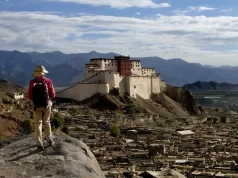
Mt. Fuji is Japan’s most iconic cultural symbol and the most recognizable mountain in the world. The UNESCO World Heritage Centre describes its profound beauty as a “Sacred Place and Source of Artistic Inspiration”. At 3,776 meters, it is the highest peak in Japan and one that attracts droves of visitors every year during the climbing season between July and September.
As of 2024, the government of Japan has implemented travel restrictions along the popular Yoshida Trail in Yamanashi Prefecture to prevent overcrowding and to preserve the nature of this destination. In addition to applying for the permit online, there is now a ¥2,000 hiking fee and an optional ¥1,000 donation towards conservation efforts. A maximum of 4,000 climbers are permitted each day, and there is no climbing from the 5th Station between 4 pm and 3 am without a mountain hut reservation.
The other three trails: Subashiri, Gotemba and Fujinomiya in Shizuoka Prefecture do not yet have new restrictions, but travellers must submit a hiking plan online and receive a QR code to present before ascending.
Beyond climbing Mt Fuji, there are several ways to experience the spectacular scenery of the area that surrounds it. These sustainable tourism experiences speak to luxury and luxe-for-less travellers seeking an easy immersion into the culture and the unspoiled nature of Japan.
The Fuji Five Lakes district at the foot of Mt. Fuji consists of pristine lakes in which to rent boats, go fishing, camping, hiking and even sink into relaxing hot springs with the unique panorama of Mt. Fuji in the mist. From cherry blossom viewing in spring to the floral profusion of tulips, cosmos and sunflowers leading into summer, and the vibrant foliage in the fall, the colours of Yamanakako Hana no Miyako Park are simply breathtaking.
Oshino Hakkai is one of many small, traditional, old-world villages in the Fuji area. It is surrounded by eight ponds of crystal-clear water. Thatched roof houses, water wheels and beautiful gardens distinguish this bucolic setting with a magnificent view of Mt. Fuji.
A quintessential taste of Japan is Japanese green tea. Visiting one of the green tea plantations near Mt. Fuji is an experience unlike anywhere else in the world. Picking fresh tea leaves amidst a picturesque setting with Mt. Fuji in the background is a once-in-a-lifetime experience. Imamiya City in Shizuoka Prefecture is home to many tea farms with stunning landscapes that change dramatically with the seasons.
Family-friendly experiences include Fuji Safari Park, home to a range of wildlife to be viewed by safari tour, day or night. Free roaming animals include lions, elephants, tigers, rhinoceroses and giraffes. There is also Fuji Q Highland, one of the most popular amusement parks in Japan. Located at the base of Mt. Fuji, it boasts world record-breaking rides including roller coasters and swings, as well as other kid-friendly attractions.
For the best Instagram views of Mt. Fuji, head to Chureito Pagoda in Fujiyoshida City. It is one of the most popular photos of the area and is often referred to as “the authentic view of Japan,” with both the five-storied pagoda and Mt. Fuji in the frame. During cherry blossom season, the contrasting colors are extraordinary. It’s 398 steps up to the bright red pagoda, located at Arakura Fuji Sengen Shrine within Arakurayama Sengen Park, which is surrounded by over 650 cherry blossom trees.
The Narusawa Ice Cave is a 153-metre-long lava tube-turned-natural refrigerator located in the Aokigahara forest. Visitors can walk through and explore the ice pillars and ice walls year-round.
There are many accessible ways to experience Mt. Fuji that are low-cost but high-end, each offering authenticity, unspoiled nature and family-friendly adventures of a lifetime.





